Before using your sun oven, you'll need to follow key safety steps to protect your health and equipment. Start by cleaning the oven chamber with hot soapy water and removing protective film from reflectors. Always preheat above 140°F, ideally reaching 200°F, and position the oven for maximum sunlight between 11 AM and 3 PM. Use food-grade gloves and separate tools for raw and cooked foods to prevent cross-contamination. Keep a digital probe thermometer handy to verify safe cooking temperatures: 145°F for whole cuts, 160°F for ground meats, and 165°F for poultry. These basic precautions are just the beginning of safe sun oven operation.
Safe Temperature Control Guidelines
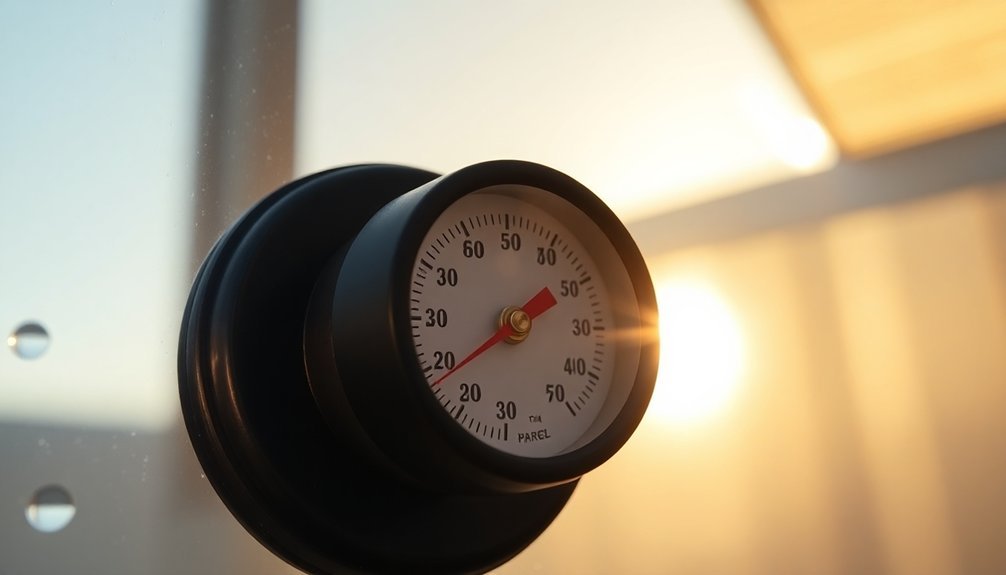
When using a sun oven, maintaining proper temperature control is essential for food safety and ideal cooking results. You'll need to preheat your oven above 140°F before cooking, with 200°F being the ideal starting temperature.
Monitor your food's internal temperature using a reliable digital probe thermometer to guarantee meats reach 145°F for whole cuts, 160°F for ground meats, and 165°F for poultry. For accurate readings, insert the thermometer into the thickest part of food.
Position your oven to maximize sunlight between 11 AM and 3 PM, and adjust it every 1-2 hours to follow the sun's path. For best results, use dark-colored cookware that absorbs solar energy effectively.
Remember that cooking times typically double compared to conventional methods, and you'll need to maintain temperatures above 145°F throughout the process to prevent bacterial growth in the food.
Proper Food Handling Steps
Before you begin cooking with your sun oven, proper food handling procedures must be followed to guarantee safety and ideal results.
You'll need to start by removing the protective film from reflectors and preheating the oven for 25-30 minutes. Clean the chamber thoroughly with hot soapy water before first use.
When handling raw foods, you can place refrigerated or frozen items in the oven hours before cooking begins, as they'll stay cold until the sun heats the chamber. Using clean single-use gloves during food preparation helps maintain proper hygiene standards.
Make sure large roasts over 4 pounds are completely thawed first. Keep raw foods separate from cooked items to prevent cross-contamination, and always use clean, dark-colored cookware.
Remember to wash your hands frequently during food preparation and store your oven with the glass door open to avoid trapped food odors.
Positioning For Maximum Solar Efficiency
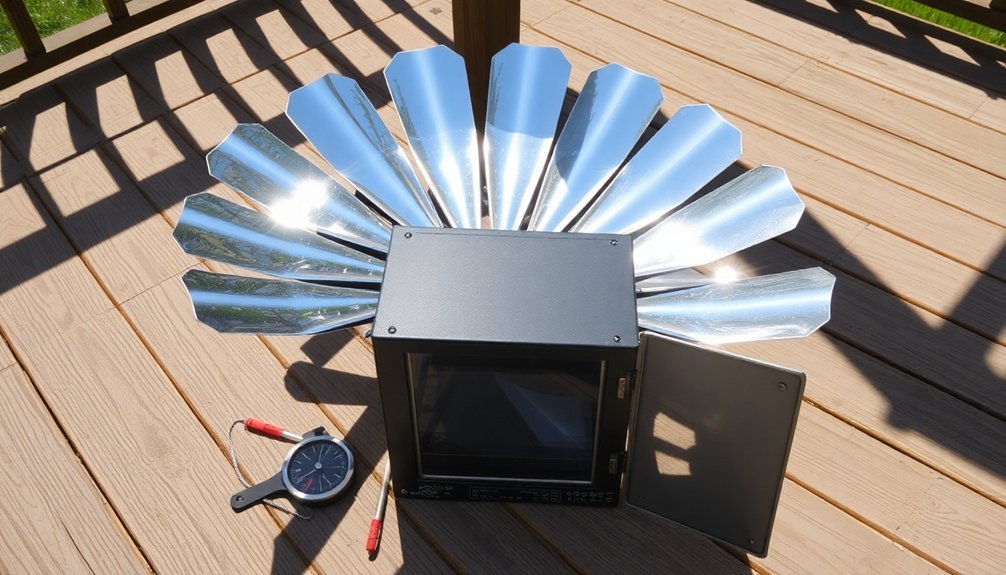
You'll need to understand the sun's daily arc across the sky to effectively position your solar oven throughout the cooking process.
Place your oven in a spot with completely unobstructed access to direct sunlight, away from buildings, trees, or anything that could cast shadows as the sun moves.
To maximize solar absorption, align the oven directly toward the sun and adjust its angle using stabilizing legs or stands, repositioning every couple of hours to maintain ideal exposure. The best cooking performance occurs when preparing meals between 10 am and 4 pm during summer months.
Tracking Sun's Daily Path
Successfully tracking the sun's daily path is essential for maximizing your solar oven's efficiency. Position your oven between 11:00 AM and 3:00 PM when sunlight is strongest, and make adjustments every 20-30 minutes to maintain ideal alignment.
You'll want to confirm the shadow falls directly behind the oven. Use the E-Z Sun-track indicators to fine-tune your positioning by centering the light dot over the bottom hole.
Watch for even shadows on both sides of the oven. Adjust your reflectors hourly, keeping them clean and properly angled for maximum reflection. If experiencing strong winds, set up natural barriers or windbreaks to maintain consistent cooking temperatures.
During winter months or shorter sun seasons, start cooking earlier around 10:00 AM and consider laying the oven on its back with reflectors open.
Remember to account for seasonal changes in sun elevation, especially if you're in higher latitudes.
Clear Sky Location Selection
After mastering sun tracking, the next key factor is selecting an ideal location for your solar oven.
You'll need an unobstructed spot that receives direct sunlight between 11:00 AM and 3:00 PM, free from shadows cast by trees or buildings.
Place your oven on a dry, level surface and use stones or the included wire stakes to secure it against wind.
The white E-Z Sun-track indicators will help you maintain perfect alignment with the sun, which you should check every 30 minutes.
Don't forget to create an air gap under your pot using a wire rack for better heat retention.
While clear, sunny days are ideal, don't worry if there's occasional cloud cover – it'll slow cooking but won't stop it.
Cold, dry air actually enhances your oven's performance due to reduced light scattering.
Angle For Peak Absorption
To achieve ideal performance from your solar oven, proper angle positioning plays a critical role in harvesting maximum sunlight.
You'll need to adjust your oven's position throughout the day to track the sun's movement and maintain best heating efficiency.
- Check and reposition your oven every 20-30 minutes, ensuring the shadow falls directly behind the cooker for direct sun exposure.
- Set your oven's angle equal to your location's latitude, using the rear alignment leg and bracket for precise elevation.
- Utilize the E-Z Sun-track indicators on your glass door corners – the sun's dot should center over the bottom hole.
- Adjust your reflector panels so the reflected rays concentrate on the opposite side of your cooking target, creating an intense heat zone.
Clean your reflector surfaces regularly and add wind barriers when necessary to maintain peak performance.
Essential Safety Equipment
When using a solar oven safely, you'll need several essential pieces of protective equipment. You'll want to protect yourself while guaranteeing food safety and proper oven operation.
| Equipment | Purpose |
|---|---|
| Food-grade gloves | Prevent germ transfer during food prep |
| Cooking thermometer | Monitor safe cooking temperatures |
| Clean utensils | Maintain sanitary food handling |
| Stakes/anchors | Secure oven in windy conditions |
| Sanitizing solution | Clean surfaces and equipment |
Keep your thermometer handy to verify the oven maintains temperatures above 140°F, ideally reaching 200°F for safe cooking. Always wear gloves when handling food and regularly sanitize your equipment, especially after four hours of continuous use. Don't forget to secure your oven properly with stakes and guarantee the solar panels are firmly attached with wingnuts to prevent accidents.
Weather and Timing Considerations
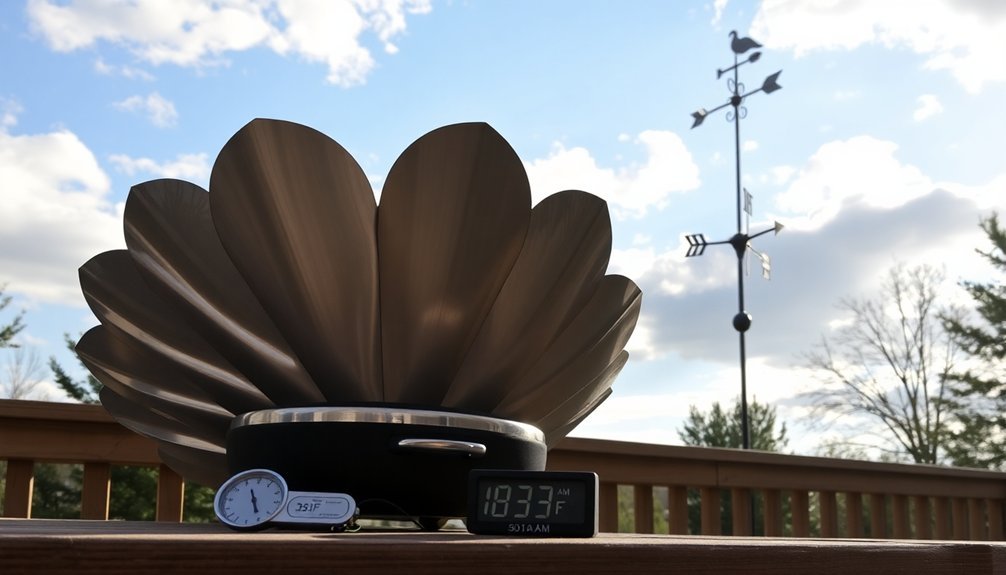
You'll want to keep seasonal sun position charts handy, as the sun's path changes considerably throughout the year and affects your cooking times.
For best results, position your solar oven where it can receive direct sunlight between 11 AM and 3 PM, when UV rays are strongest.
Clear, windless days with ample sunshine work best, while cloudy or overcast conditions will limit your cooking capabilities.
Seasonal Sun Position Charts
Understanding seasonal sun position charts is essential for maximizing your sun oven's efficiency throughout the year. These charts help you track the sun's path and identify potential shading issues that could affect your cooking performance.
You'll need to take into account your latitude, as it greatly impacts the sun's angle, especially during winter months.
For ideal sun oven placement using position charts:
- Track the sun's path between 10 AM and 4 PM to identify the best year-round location.
- Use a Solar Pathfinder to map potential tree shadows and obstacles.
- Document seasonal variations in sun angles to plan T-leg adjustments.
- Mark spots where reflective interference might occur with nearby windows.
Remember to reassess your position charts seasonally, as new obstacles like tree growth can alter your ideal cooking spot.
Best Weather Conditions
Successful sun oven cooking depends heavily on selecting ideal weather conditions and timing. You'll get the best results on clear, sunny days when temperatures can reach 300°F to 400°F. Look for times when you can cast a shadow, as this indicates sufficient direct sunlight for cooking.
Plan your cooking between 10 AM and 4 PM, with prime temperatures occurring from 11 AM to 3 PM. You'll need to preheat your oven for 25-30 minutes and realign it every half hour to maintain maximum efficiency.
While cloudy days aren't ideal, you can still cook by allowing extra time and using reflective panels to concentrate available light. Choose a wind-protected location and keep your reflectors clean for peak performance.
Remember that summer months offer longer cooking windows compared to winter.
Clean Equipment Requirements
Maintaining a clean sun oven setup requires four essential equipment groups: cleaning utensils, sanitizing solutions, drying materials, and storage containers.
You'll need to keep these items readily available to guarantee proper hygiene and food safety during your solar cooking sessions.
Follow these critical cleaning requirements for your sun oven:
- Clean and sanitize all utensils before switching between different foods to prevent cross-contamination and allergen transfer.
- Wipe the oven's interior, reflector panels, and glass door with appropriate cleaners after each use.
- Keep your cooking area dry and sanitized, promptly cleaning any spills or food residue.
- Store cleaned equipment in sealed containers to maintain their sanitized state.
Remember to check your cleaning tools every 4 hours during continuous use, and always remove moisture from the oven before storage.
Preventing Cross Contamination
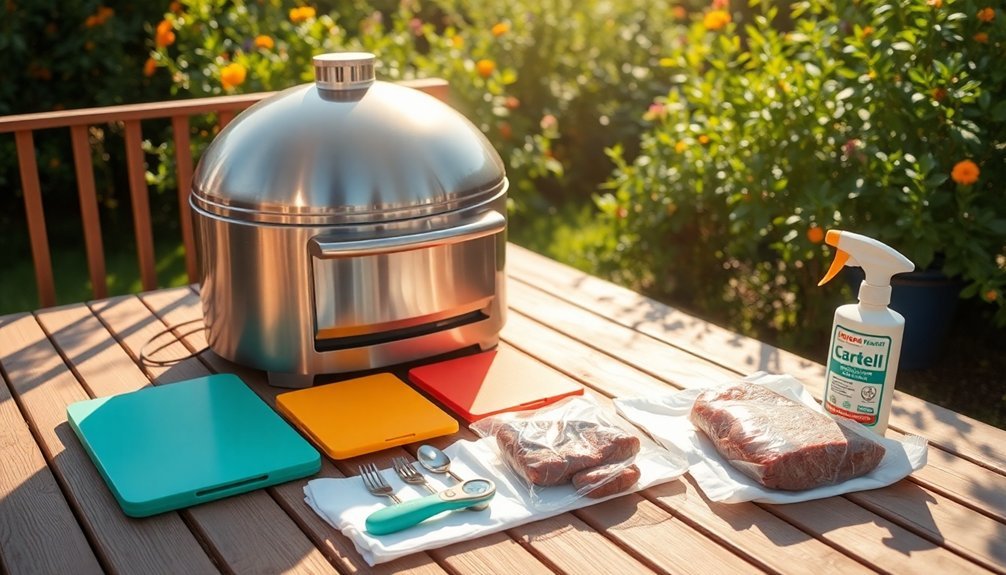
Clean equipment plays an essential role in food safety, but proper handling practices take your sun oven's hygiene to the next level. You'll need to prevent cross-contamination by keeping raw foods separate from cooked ones and using dedicated utensils for different food types. Always wear clean gloves when handling food and wash your hands thoroughly for 20 seconds with warm water and soap.
| Prevention Step | Why It Matters | How to Do It |
|---|---|---|
| Separate Tools | Prevents pathogen transfer | Use different cutting boards |
| Hand Hygiene | Reduces germ spread | Wash 20+ seconds with soap |
| Food Storage | Avoids drip contamination | Raw below ready-to-eat |
| Surface Care | Eliminates bacteria | Clean and sanitize after use |
| Temperature | Kills harmful organisms | Cook to proper internal temp |
Remember to store raw meats below ready-to-eat foods and maintain proper cooking temperatures: 145°F for whole cuts, 160°F for ground meats, and 165°F for poultry.
Storage and Maintenance Protocols
Proper care of your sun oven begins with smart storage and regular maintenance routines.
Store your oven in a dry, well-ventilated area away from direct sunlight and rain, using protective covers when needed. Don't forget to wipe away moisture and leave the glass door unlatched to prevent condensation buildup.
To maintain your sun oven's peak performance:
- Clean the interior after each use with a soft sponge and mild vinegar solution, avoiding abrasive materials.
- Keep reflector panels pristine using glass cleaner and a soft cloth.
- Apply silicon lube to the rubber gasket regularly to maintain flexibility.
- Touch up any damaged interior paint with high-temperature black paint.
Remember to store all accessories in labeled containers and keep components together in their original packaging whenever possible.
Frequently Asked Questions
Can I Cook Frozen Food Directly in the Sun Oven?
Yes, you can cook frozen food directly in your Sun Oven, but you'll need to guarantee it's preheated above 180°F. Remember that cooking times will be longer, and large items like turkeys must be thawed first.
How Do I Prevent Animals From Being Attracted to Cooking Smells?
You'll need to keep your cooking area clean, use covered pots, store food in sealed containers, and dispose of waste properly. Position your oven so wind carries smells away from wildlife areas.
Will Cooking in Cloudy Conditions Affect Food Safety?
Yes, cloudy conditions will affect food safety. You'll need to considerably extend cooking times and carefully monitor temperatures. Keep your food above 140°F and guarantee it reaches 165°F internally to prevent bacterial growth.
Can Multiple Dishes Be Cooked Simultaneously at Different Temperatures?
No, you can't cook dishes at different temperatures simultaneously in a Sun Oven. The oven maintains one uniform temperature throughout the chamber, so you'll need to cook foods requiring similar temperatures together.
Does Altitude Affect Cooking Times in a Sun Oven?
Yes, altitude will affect your Sun Oven cooking times. You'll need to adjust for lower atmospheric pressure and faster moisture loss, though the oven's maximum temperature remains consistent. Monitor your food carefully.
In Summary
You'll get the most out of your sun oven by following these essential safety steps. Always monitor temperatures, handle food properly, and position your oven for ideal sunlight. Don't forget your safety gear, and pay attention to weather conditions. Keep your equipment clean, prevent cross-contamination, and maintain proper storage protocols. With these precautions in place, you're ready to enjoy safe solar cooking.

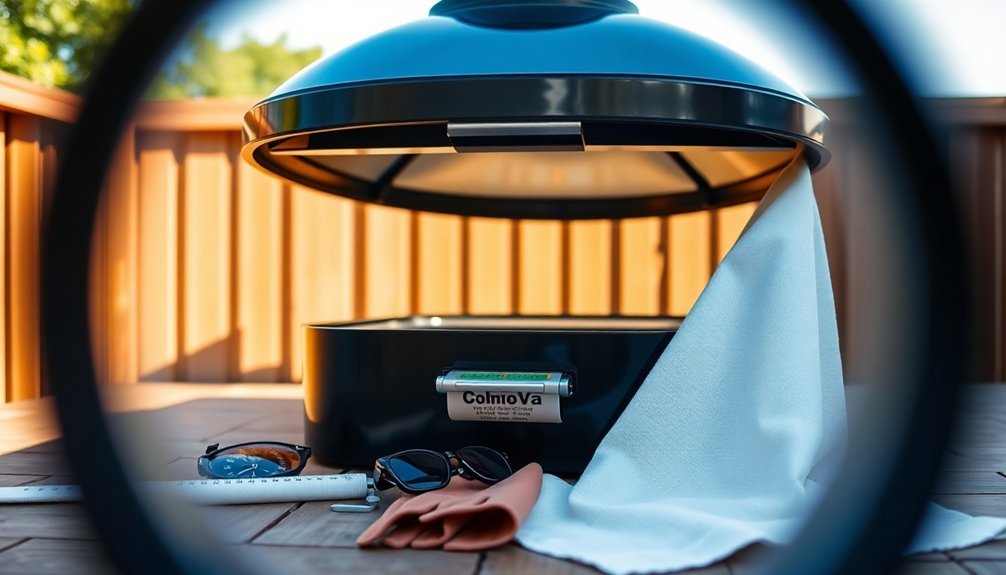



Leave a Reply